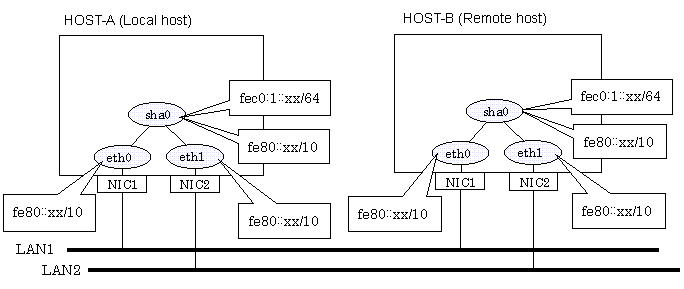

| PRIMECLUSTER Global Link Services Configuration and Administration Guide: Redundant Line Control Function 4.1 (for Linux) |
Contents
Index
 
|
| Appendix B Examples of configuring system environments | > B.2 Example of configuring Fast switching mode (IPv6) |
This section describes an example configuration procedure of the network shown in the diagram below.
The xx in the figure below are assigned automatically by the automatic address configuration.
For the network configuration other than GLS, refer to "3.2.2 Network configuration".

1-1) Configure /etc/sysconfig/network-scripts/ifcfg-ethX (X is 0,1) file as follows.
- Contents of /etc/sysconfig/network-scripts/ifcfg-eth0
|
DEVICE=eth0 |
- Contents of /etc/sysconfig/network-scripts/ifcfg-eth1
|
DEVICE=eth1 |
1-2) On the /etc/sysconfig/network file, define a statement allows the system to load IPv6 module.
|
NETWORKING=yes |
Run the following command to reboot the system. After rebooting the system, verify eth0 and eth1 are enabled as an IPv6 interface using ifconfig command.
/sbin/shutdown -r now
/opt/FJSVhanet/usr/sbin/hanetconfig create inet6 -n sha0 -m t -t eth0,eth1
Create /etc/radvd.conf file and set the followings
interface sha0
{
AdvSendAdvert on; # Sending router advertisements
MinRtrAdvInterval 3;
MaxRtrAdvInterval 10;
prefix fec0:1::0/64 # Sending Prefix fec0:1::0/64 from sha0
{
AdvOnLink on;
AdvAutonomous on;
AdvRouterAddr on;
};
}; |

In the server that runs Fast switching mode, configure two or more router as IPv6 router. If the IPv6 router breaks down, it cannot use site-local address to communicate. To prevent this, it is recommended to setup at least two IPv6 routers.
Depending on the version of radvd, kernel parameter(net.ipv6.conf.all.forwarding=1) must be defined in /etc/sysctl.conf file. For details on /etc/radvd.conf, refer to the radvd.conf(5), radvd(8) manual. In addition, when a system is SLES, please define a /etc/sysconfig/sysctl file as follows.
|
IPV6_FORWARD=yes |
Run the following command and reboot the system.
/sbin/shutdown -r now
1-1) Configure /etc/sysconfig/network-scripts/ifcfg-ethX (X is 0,1) file as follows.
- Contents of /etc/sysconfig/network-scripts/ifcfg-eth0
|
DEVICE=eth0 |
- Contents of /etc/sysconfig/network-scripts/ifcfg-eth1
|
DEVICE=eth1 |
1-2) On the /etc/sysconfig/network file, define a statement allows the system to load IPv6 module.
|
NETWORKING=yes |
Run the following command to reboot the system. After rebooting the system, verify eth0 and eth1 are enabled as an IPv6 interface using ifconfig command.
/sbin/shutdown -r now
/opt/FJSVhanet/usr/sbin/hanetconfig create inet6 -n sha0 -m t -t eth0,eth1
Create /etc/radvd.conf file and set the followings
interface sha0
{
AdvSendAdvert on; # Sending router advertisements
MinRtrAdvInterval 3;
MaxRtrAdvInterval 10;
prefix fec0:1::0/64 # Sending Prefix fec0:1::0/64 from sha0
{
AdvOnLink on;
AdvAutonomous on;
AdvRouterAddr on;
};
}; |

In the server that runs Fast switching mode, configure two or more router as IPv6 router. If the IPv6 router breaks down, it cannot use site-local address to communicate. To prevent this, it is recommended to setup at least two IPv6 routers.
Depending on the version of radvd, kernel parameter(net.ipv6.conf.all.forwarding=1) must be defined in /etc/sysctl.conf file. For details on /etc/radvd.conf, refer to the radvd.conf(5), radvd(8) manual. In addition, when a system is SLES, please define a /etc/sysconfig/sysctl file as follows.
|
IPV6_FORWARD=yes |
Run the following command and reboot the system.
/sbin/shutdown -r now
Contents
Index
 
|